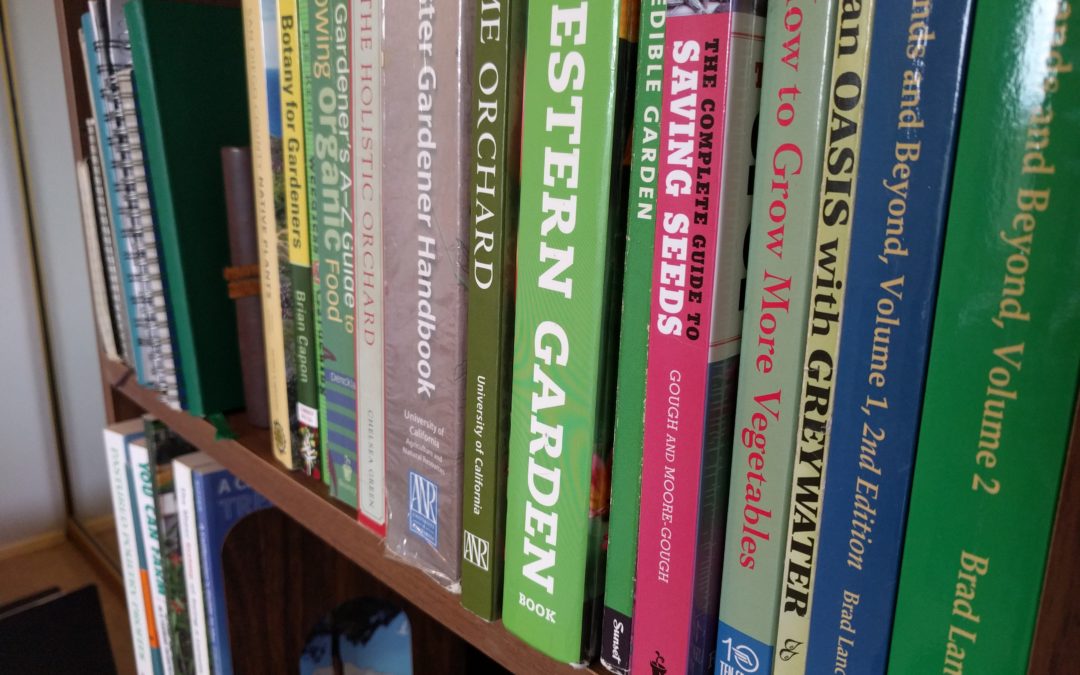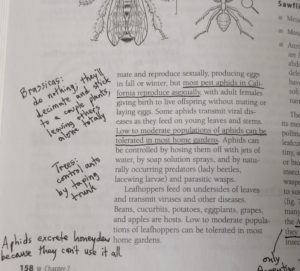A few months ago, I edited my bookshelf down to twenty gardening-related books. Of these twenty, three stand out: California Master Gardener Handbook, Sunset Western Garden Book, and The Home Orchard. These three have been, over the years, the most useful to me as a gardener who grows mostly fruits and vegetables, and who lives in Southern California.
Gardening is local. And the authors of these books live, maybe not down the street, but not too far from here. The importance of that cannot be overstated.
To give you a little confidence in my choices, let me mention that I believe I’ve read every widely-available book that is relevant to food gardening in Southern California, including the well-known books of Pat Welsh and Robert Smaus. There are many good books out there. My top three feel more indispensable than the others; they are the three that I pull off the shelf most often.
California Master Gardener Handbook
Stacking up at about 700 pages, the California Master Gardener Handbook reads surprisingly fast for being so detailed and having been written by a team of academics. That’s because it’s not written for academics. It’s not even written for “Master Gardeners”. The CMGH functions as a manual for people training to become Master Gardeners.
Because of that, the book assumes the reader has no prior horticultural knowledge. It explains everything from the ground up, and it does explain everything. The CMGH is the most comprehensive book on gardening that I’ve ever encountered. Covered: how to eliminate Bermuda grass, the life cycle of a pill bug, charts of local evapotranspiration rates, pruning blueberries, the number of calories in an average kiwifruit, climate zones for growing citrus, rootstocks commonly used for peach trees, the process for diagnosing plant problems, and on and on.
If you read this technical but very accessible book, you truly get an education in all things gardening (all oriented toward California conditions). When I did my Master Gardener training in 2012, our first class was taught by Dennis Pittenger of UC Riverside, who is the editor of this Master Gardener Handbook. Throughout the training classes, I took notes in the margins of my Handbook (see above). These days I continue to refer to them. Opened often are the chapters on water, soil and fertilizer, as well as citrus and avocado trees.
Sunset Western Garden Book
The Sunset Western Garden Book is sometimes called the Bible of gardening here in California. Go to your local retail nursery and you’re sure to see a well-worn copy of it on the service desk. It’s another thick book — another 700 pages plus. But it’s about 50 percent photos; it’s more like an overgrown magazine than a textbook. It has short sections on garden design, climate, plant choices for various situations and desired effects, weeds, pests, fertilizing, watering, planting, but the bulk of the book is an A-Z guide to growing 9,000 different plants which do well somewhere in the western United States (west of the Rocky Mountains).
The Sunset Western Garden Book offers growing information about specific fruit trees and vegetables in this A-Z guide, and that is its prime benefit to food gardeners of Southern California. For example, there are five pages on apples, including a chart of apple varieties that do well in different subclimates of Southern California. And there are also six pages of charts showing when to plant different vegetables according to exactly where you live in Southern California.
So, whereas you’re going to use the California Master Gardener Handbook to better understand the way a peach tree is grown using a rootstock and scion, you’re going to refer to the Sunset Western Garden Book to consider which variety of peach tree to grow in your particular subclimate (“Sunset Zone”).
The Home Orchard
Speaking of peach trees, there is no better resource for how to plant, train, prune, water and fertilize them in California than The Home Orchard. Ditto for growing all of the other types of deciduous fruit and nut trees: apples, pomegranates, plums, figs, pecans, almonds, apricots, etc.
The Home Orchard is published by the University of California and is written by a group of experts who live in different parts of our state. I find the book’s presentation exceptionally clear, with helpful photographs of things like a fruiting spur on an apple branch. In addition, I appreciate that the book explains fundamentals like planting a bare root tree while also diving into more advanced topics like grafting (again with excellent accompanying photos). I can’t recall a time when I needed help with an issue related to growing deciduous fruit trees and had to look beyond the pages of this single book.
(I recently wrote a post giving a longer review of The Home Orchard here.)
But what if I could only keep one gardening book on my shelf? Ouch! Even the thought hurts. But if I had to choose, I’d hold onto the California Master Gardener Handbook until the very end.
Honorable mentions
As gardening in Southern California revolves around adding water, I would be remiss if I didn’t mention these additional two (actually, three) books that I have found very useful in learning how to make the most of our paltry rainfall and in learning how to reuse household water in the garden.
Brad Lancaster’s series of books titled Rainwater Harvesting for Drylands and Beyond demonstrate his first-hand experience and are rich with diagrams and photographs. Volume 1 is an overview of principles and methods for “welcoming rain into your life.” Volume 2 has the subtitle of “Water-Harvesting Earthworks,” by which is meant things like ditches for water to pool in, rock dams across gullies, and half-moon shaped berms to prevent runoff. If I had to choose only one, I’d go with Volume 1. While Lancaster lives in Tuscon, Arizona, where rain falls primarily in the summer, we in dry-summer Southern California can still apply much from these books with only minor adjustments.
Art Ludwig has been practicing what he preaches in Southern California for decades, and his book Create an Oasis with Greywater can help you skip over common errors in attempting to reuse household water in your yard. The information in the book is grounded in Ludwig’s personal experience and not, say, the unrealistic recommendations of academics or bureaucrats. The text is permeated with helpful numbers, drawings, and real-life examples. Perhaps the title is the only part of the book that I’m not satisfied with, as the only way you’re going to use graywater to create an “oasis” — like the one shown on the book’s cover — is if you turn on your faucets and use a lot of imported water in the first place (and therefore pay for all that piped-in water).
Nevertheless, I wholeheartedly agree with this quotation from the book: “Lifestyle change is far and away the best way to conserve resources . . . If you can choose between reducing and reusing, reducing is the priority.” In a sense, it undermines the thesis of the book and yet Ludwig is honest and willing to say it.
On a personal note: Before I gardened in Southern California, I lived and gardened in Africa, where capturing rainfall and reusing water was the norm. I’d read no books about it; I just followed the lead of the Africans among whom I lived. So I brought that raw experience back home to Southern California and draw from it when I assess books like the two above — and indeed, when I consider the quality of the advice of my top three favorite books, as well.
You might also like to read my posts:
Teaming with Microbes: a book review
Reading my grandma’s 1961 Sunset Western Garden Book (My, how things have changed)
Davis Garden Show — best radio podcast for Southern California gardening










Thanks for the Christmas gift idea!!
As Vice President of the San Diego Geranium Society, it is my privilege to find speakers for our meetings which are the second Tuesday of the month in Balboa Park, San Diego, Casa Del Prado room 101.
We would love to have you come and speak to us about Home gardens, rainwater irrigation and propagation of Fruit trees. Anything appropriate about gardening in April in San Diego. April 9th is the target date.
Please let us know if you are available. We gladly pay for your time.
Found this post at the perfect moment: when I realized that my garden book library simply doesn’t have what I need to garden in San Diego! I *just* got the CMGH and I am committing to memory a lot of the “technical” stuff because adapting to gardening here is proving to have a steep learning curve! Getting the “why” behind the “how to” garden in my new home really helps me make better garden decisions.
I think the orchard book is my next addition. We only have 7 fruit trees, but we dream of more! Thanks for bringing these books to my/our attention. Gene
Hi Gene,
Thanks for bringing this post back to my attention. It’s a good time of year for me to remind readers that it exists. I’m also going to add a few updated notes on those “best three.” You will not regret getting a copy of The Home Orchard.
🙂
And…I recently discovered that FEDCO, the seed & supplies company in Maine that I’ve trusted for decades, carries an organic fruit tree care kit for the home orchard. There’s a schedule for treatment included and it was developed by a successful organic fruit grower. In case this company is unfamiliar, I’d like to offer that in my experience the FEDCO seed germination rate is nearly 100%, prices and shipping rates reasonable, and their catalog offers the greatest variety of seeds (both organic and conventional, heirloom and hybrid, home grower and commercial farmer packs) find what you’re looking for all in one place:).
Thanks for the recommendations! I just purchased the Master Gardener and the Home Orchard book for myself for Christmas.